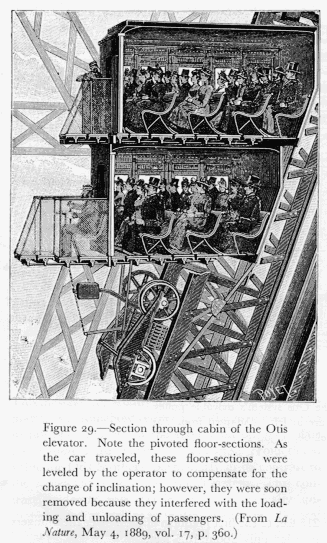Eiffel's Elevators
Today, Gustave Eiffel gives inventive minds a lift. The University of Houston's College of Engineering presents this series about the machines that make our civilization run, and the people whose ingenuity created them.
Eiffel opened his famous Tower at the 1889 Paris Exhibition. While he was building it, inventors were trying to give birth to the electric elevator. Ten years later he probably would have used an electric elevator, but for now he had a problem. And solving it created a great design laboratory.
Carrying people a thousand feet into the sky was daunting enough, but Eiffel's worst problem was at the base of the Tower. The four legs spread out, leaving a great open archway through the base. The arch was well over a hundred feet high and more than 200 feet across. An elevator shaft in the middle of that lovely arcade was unthinkable.
Hydraulic-drive cable elevators were well known. They'd never been used on such a scale, but there was no reason not to use them. Eiffel hired a French firm to build one for the 550-foot run from the second landing to the top of the Tower -- one that began 380 feet above the ground. He had a much harder time finding someone to fit an elevator into the curved lower legs of the Tower.
Eiffel finally rejected a wild English screw-driven system and turned to the American Elisha Otis. Otis was ready for him. He was sure no one else could do the job, so he had simply designed a system and then sat back to wait for Eiffel's call.
Otis made two huge hydraulic cable elevators for two opposing legs. They were half elevator, half inclined railroad -- very big and very complicated. They were also beautiful machines that drew crowds at the Exhibition.
French nationalism demanded that French elevators be put into the other two legs. Someone came up with a clumsy, but wildly inventive, chain-drive elevator that went only to the first platform. Later Eiffel muttered that its only merit was looking safe enough to satisfy bureaucrats. Those French elevators were the first to be replaced after the Exhibition.
The Otis elevators were avant-garde technology. But before WW-I they also gave way to simpler systems. The surprise was the French elevator in the upper part of the Tower. Once the longest elevator run ever built, it'd gone in with little fuss. It would've been replaced with an electric elevator when cold weather kept freezing its hydraulic drive; but someone added antifreeze, and it kept running for a century.
The rising Eiffel Tower clearly heralded a new age in high-rise thinking, and it drew in ideas. Some died on the drawing board. Some survived. But inventors knew that when the Tower was finished, buildings would never be quite the same again.
I'm John Lienhard, at the University of Houston, where we're interested in the way inventive minds work.
(Theme music)
Vogel, Robert M., Elevator Systems of the Eiffel Tower, 1889. United States National Museum Bulletin 228, Washington, D.C.: Smithsonian Institution, 1961.

From the reference above